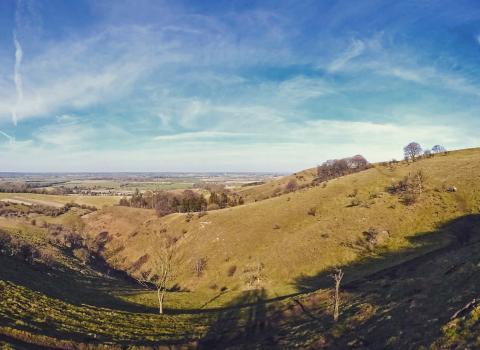The highlights for me were some scarce beetles: Scymnus schmidti, Platynaspis luteorubra, Brachysomus echinatus, Squamapion cineraceum, and Pseudorchestes pratensis at Pegsdon, and Squamapion flavimanum and Orthochaetes insignis at Totternhoe, some of which seem to be new for Bedfordshire.
Lesser of two weevils
Scymnus schmidti is one of the smaller ladybirds. It is less glamorous than its larger relatives, mostly black, and not easy to tell apart from several other small, black ladybirds. This is probably why it has not made it onto the county list before. It likes grass and heathland and is widespread but rarely reported in southern Britain.
Platynaspis luteorubra (above) is another small ladybird, but this one is more like a ladybird, with its red spots. It has a cute face with big sad eyes. This is a scarce ladybird, fond of chalk grassland, where it lives with ants. The larvae live inside the ant nest, where they eat underground aphids. Its presence at Pegsdon is testimony to the the lovely ant-hill grassland. This seems to be the first record for the county.
Brachysomus echinatus is a tiny, rather fat weevil beset with little thick spines. It lives at the roots of various plants, where it is not easy to find. The vacuum sampler was invaluable for finding this one.
Squamapion cineraceum (no photo) is new for Bedfordshire. Despite feeding on one of our commonest plants, Self-heal, this a scarce little weevil. It seems to have a preference for chalky soils.
Pseudorchestes pratensis is one of the flea weevils, which have large hind legs with which they can jump quite alarming distances. Most of them feed on trees, but Pseudorchestes pratensis is an exception, as it eats knapweeds, typical plants of chalk grassland. This has been found at other chalk sites in the county.
Squamapion flavimanum is another addition to the Bedfordshire list. It is like Squamapion cineraceum, but it feeds on Marjoram and perhaps Wild Basil and other members of the mint family. It has not been much recorded in Britain recently, but it is a difficult thing to find.
Orthochaetes insignis is another first for Beds from the vacuum sampler. Use of these entomological hoovers has uncovered this species at more sites recently, and it appears to be widespread but uncommon. It probably feeds at the roots of plants in grasslands, so it is often in the leaf litter or just under the surface of the soil where it is well hidden.


